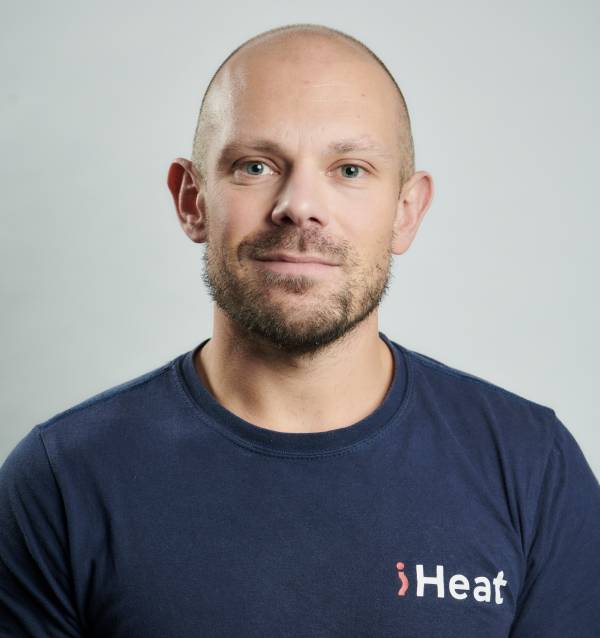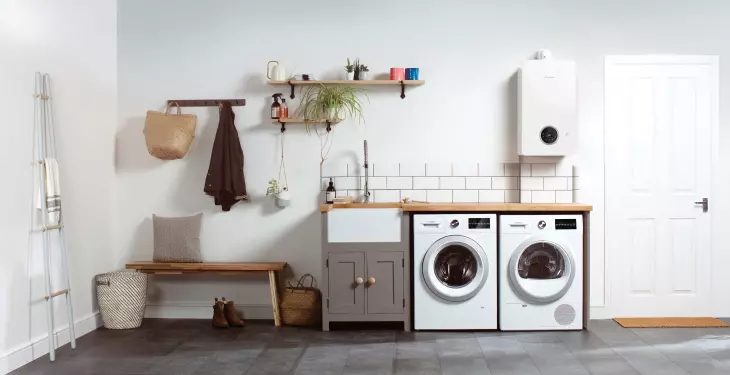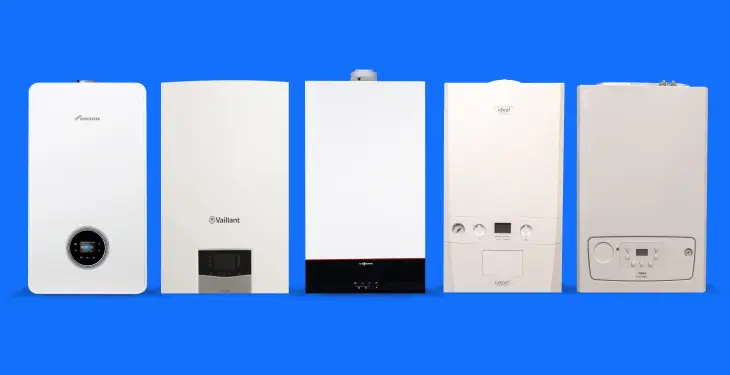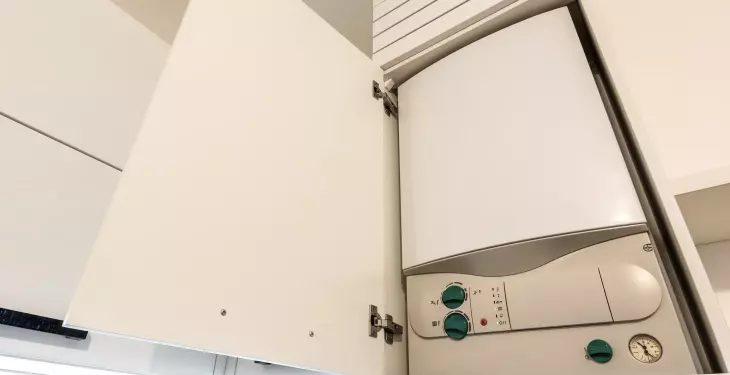

Written by Stephen Day
Gas Safe Engineer
Updated: 30th May, 2025
For most UK homes, setting the hot water tank thermostat between 60°C and 65°C provides a good balance of comfort and safety. This temperature is warm enough to supply comfortable hot water while helping to reduce the risk of bacteria like Legionella.
Get a new boiler quote, save up to £550 per year (0% APR available).
A hot water tank thermostat is a key part of keeping your home comfortable and energy-efficient. In the UK, setting and maintaining your hot water tank thermostat correctly helps ensure you have enough hot water without wasting energy or risking scalding. Getting the right temperature and knowing when your thermostat needs adjusting or replacing can make a big difference to your bills and daily routine.
Many people in 2025 are looking for simple answers about hot water tank thermostats—how they work, common problems, and the safest settings for their home. This guide covers all you need to know, from adjusting for better efficiency to staying safe and spotting signs that something might be wrong.
Get a quote in 60 seconds, fitted as fast as next day!
0% APR finance available.
A hot water tank thermostat can stop heating for many reasons. One common issue is dead batteries in wireless thermostats. When the batteries run out, the device cannot signal the boiler to heat the water.
Wiring issues may prevent the thermostat from working properly. Loose or damaged wires can break the connection between the thermostat and the hot water cylinder or boiler.
Incorrect temperature settings are another simple cause. If the thermostat is set below 21°C, the boiler might not turn on at all, leaving your water cold.
Sometimes, a build-up of dust or dirt inside the thermostat restricts its performance. This can stop it from reading the temperature properly.
Water pressure problems may also contribute. Low water pressure in the hot water cylinder can cause the system to stop heating as expected.
Here is a quick overview:
Possible Cause | Effect |
Dead batteries | Thermostat does not send signals |
Wiring issues | No connection to boiler or cylinder |
Low temperature setting | Boiler never turns on |
Dust/dirt in thermostat | Incorrect temperature reading |
Low water pressure | Hot water not heating effectively |
A faulty thermostat sometimes produces temperature swings, with hot water one moment and cold the next. This can point to a failing sensor or internal component.
If your cylinder has its own thermostat or programmer, check those settings closely. Incorrect or outdated settings might cause heating issues, especially with older systems.
For most UK homes, setting the hot water tank thermostat between 60°C and 65°C provides a good balance of comfort and safety. This temperature is warm enough to supply comfortable hot water while helping to reduce the risk of bacteria like Legionella.
Locate the thermostat—it is usually a dial or digital control on the tank’s side.
Turn the dial to your chosen setting, usually marked in degrees Celsius.
Wait at least an hour before testing the water temperature at the tap.
Adjust again if necessary for your preferred comfort level.
Check the room thermostat and radiators separately; they control central heating, not hot water.
Tip: Using a timer to heat your water only when needed saves energy. For example, set it to heat up an hour before you wake up.
Here is a simple table to help you choose the right setting:
Setting | Water Temperature | Best For |
Low | 50–55°C | Energy saving, not advised for health safety |
Recommended | 60–65°C | Comfort and safety |
High | 70°C+ | Excessive, can scald skin |
Avoid setting the thermostat below 60°C, as this may lead to bacteria growing in your tank. Use a thermometer to double-check your tap water if you are unsure. Regularly check both hot water and room thermostats to make sure your home is comfortable and safe.
Hot water tank thermostats can develop several issues, especially in both vented and unvented cylinders. A faulty thermostat can mean lukewarm water, water that is too hot, or even no hot water at all.
Common Problems:
Incorrect water temperature
No hot water output
Unusual noises
Erratic heating or cooling
Faulty readings on the thermostat dial
Wiring or connection issues
If the immersion heater is always on or never turns on, the thermostat might be stuck or set to the wrong temperature. For vented cylinders, this can lead to overheating or lack of hot water.
On unvented cylinders, a faulty thermostat can cause safety issues. Water may get much hotter than safe levels, or you might notice that it does not heat at all.
Often, the fix is simple:
Check these steps first:
Make sure the thermostat is set between 60°C and 65°C.
Replace batteries if using a battery-powered or wireless thermostat.
Inspect for loose or burnt wiring connections.
For immersion heaters, reset any safety cut-outs before replacing the thermostat.
If water stays too hot, the thermostat may need replacing.
Issue | Likely Cause | Simple Fix |
Water too hot or too cold | Thermostat setting off | Reset temperature dial |
No hot water | Blown fuse, wiring | Check fuse and wiring |
Immersion heater not working | Faulty thermostat | Replace thermostat |
If problems continue after these checks, it might be necessary to call a qualified heating engineer to inspect your system. Thermostats wear out over time, and both vented and unvented cylinders can be affected.
Replacing a hot water tank thermostat can improve efficiency and help keep your water at the right temperature. Most people can replace a thermostat with just a few tools and some basic safety steps.
Tools Needed:
Insulated screwdriver
Adjustable spanner
Voltage tester
A new thermostat (make sure it matches the tank type)
Step-by-Step:
Switch off the power supply to the hot water cylinder at the mains.
Use a voltage tester to make sure there is no electricity going to the thermostat.
Remove the cover from the old thermostat, using the screwdriver.
Loosen the terminal screws and gently pull out the old thermostat.
Put the new thermostat in place and connect the wires to the correct terminals.
Tighten all screws and replace the cover.
Turn the power back on and test the system.
Cost Estimate Table:
Item | Cost Range (2025) |
New Thermostat | £20 - £40 |
Professional Fitting | £70 - £110 |
Hiring a professional is recommended if unsure about electrical work.
Make sure to set the new thermostat to the recommended temperature, usually around 60°C, to prevent bacteria and save energy. Always check the manufacturer's guide for specific instructions related to your hot water cylinder.
A faulty thermostat can cause problems with both safety and comfort. Recognising the signs early can prevent bigger issues.
Key signs your hot water tank thermostat might need replacement include:
Water temperature is inconsistent
Sometimes the water is too hot, sometimes too cold. This is often the first clue.
No hot water at all
If the heating system is on but you only get cold water, the thermostat could be at fault.
Water is too hot
Water that feels dangerously hot is not just uncomfortable—it can be unsafe. This may mean your thermostat isn’t switching off as it should.
Visible damage
Look for signs like burn marks, corrosion, or cracks on the thermostat.
A sudden rise in energy bills can also hint at a thermostat problem, as it may fail to regulate temperature properly.
Some thermostats show an error code or warning light if something is wrong. Not all models have this feature, so check your manual.
Here is a quick checklist:
Symptom | Possible Issue |
Inconsistent water temperature | Faulty sensor |
Only cold water | Broken thermostat |
Water too hot | Stuck or failed relay |
No response from controls | Electrical failure |
If you experience any of these issues, it is often best to consult a qualified heating engineer.
Setting the right temperature on a hot water tank thermostat is important for both safety and efficiency. The recommended range in the UK is typically between 60°C and 65°C.
Water heated to at least 60°C helps stop the growth of Legionella bacteria, which can cause Legionnaires' disease. A lower setting may increase the risk of bacteria forming.
If the temperature is set too high, there is a risk of scalding. Hot water at 60°C can cause burns in just one second. It is essential to balance safety against energy use and health risks.
Most experts recommend setting the hot water tank thermostat to 60°C. This temperature is high enough to kill harmful bacteria but not so high that it greatly increases energy bills.
Below is a simple table for quick reference:
Setting | Temperature | Purpose |
Energy Saving | 60°C | Kills bacteria, lowers energy use |
Extra Safety | 65°C | Added protection against bacteria |
Avoid | Below 60°C | Risk of Legionella and other bacteria |
Avoid | Above 65°C | Higher risk of scalding, more energy consumption |
It is good practice to check the thermostat regularly to make sure it is set correctly.
Children, older people, and those with reduced mobility are more at risk from hot water burns, so extra care should be taken in homes with vulnerable people.
Using a mixer tap or installing thermostatic mixing valves at the taps can further protect against accidental scalding while keeping the tank at a safe temperature.
Regular checks of the hot water tank thermostat help keep the heating system safe. Water that is too cold (below 50°C) can allow harmful bacteria, like Legionella, to grow. At the same time, water that is too hot may cause scalding.
Keeping water between 60°C and 65°C is the recommended range for most UK homes. This not only protects household health but also improves comfort at the tap. It makes sure the home heating system runs as efficiently as possible.
Energy use can increase if the thermostat is not set properly. An unchecked thermostat might mean the heating system works too hard or not enough. This could result in higher energy bills or wasted heat.
Checking the thermostat regularly offers benefits such as:
Consistent hot water temperature: Reduces sudden changes at the tap
Energy savings: Keeps the heating system working efficiently
Safety: Prevents scalds and stops bacteria from growing
A faulty thermostat can affect both comfort and safety in the home. Spotting issues early allows for quick repairs and helps avoid bigger problems later. Homeowners should make checking their hot water tank thermostat a routine part of home care.
To increase efficiency, the hot water tank thermostat should be set between 60°C and 65°C. This range provides hot water that is safe for use and helps prevent bacteria like Legionella from growing.
If the temperature is set too high, it can waste energy and raise household bills. Temperatures below 50°C should be avoided because they can lower performance and pose health risks.
Steps to Adjust Your Thermostat:
Locate the thermostat on the side of your hot water tank.
Turn the dial or use the digital control to set the temperature.
Wait a few hours, then check if the water is at the right heat level.
Most modern boilers now have digital heating controls. These controls make it easier to choose the exact temperature. Using a timer can also help. Set the timer to heat water only when needed; this saves energy by avoiding unnecessary heating cycles.
Performance and Energy Saving Table
Action | Effect |
Set between 60°C-65°C | Saves energy, safe temperature |
Use a timer | Reduces energy use |
Check thermostat regularly | Maintains performance |
Keeping the thermostat at the correct temperature helps the system run smoothly. This simple change can improve performance and lower costs.
Get a quote in 60 seconds, fitted as fast as next day!
0% APR finance available.
Last updated: 30th May, 2025

Written by Stephen Day
Gas Safe Engineer at iHeat
Stephen Day is a Gas Safe registered and FGAS certified engineer with over 20 years of hands-on experience in the heating, cooling, and renewable energy industry, specialising in boiler installations, air conditioning, and heat pump systems.
LinkedInArticles by Stephen Day are reviewed by iHeat’s technical team to ensure accuracy and reliability.

19th December, 2025
The best budget boilers are Ideal, Alpha, Baxi, Worcester Bosch and Vaillant models, compa...
 Read Article
Read Article

19th December, 2025
The most reliable boiler brands in the UK: Worcester Bosch, Vaillant, Ideal, Viessmann, an...
 Read Article
Read Article

19th December, 2025
An airing cupboard is a heated storage space that uses warmth from a hot water cylinder or...
 Read Article
Read Article
No obligation. Takes less than 60 seconds.